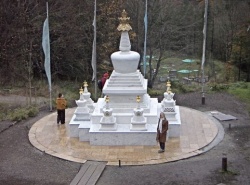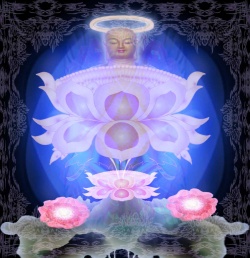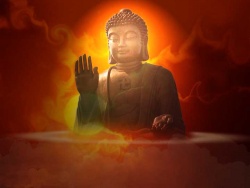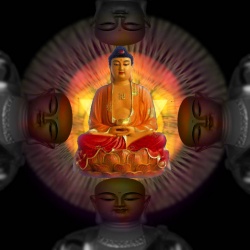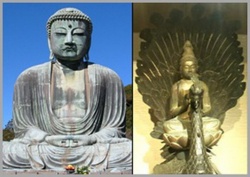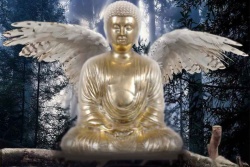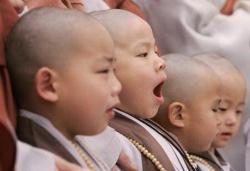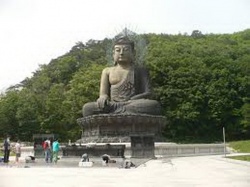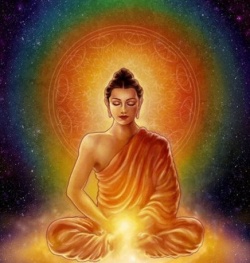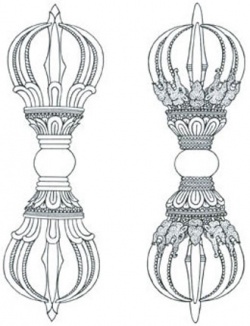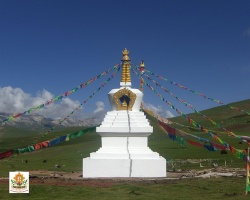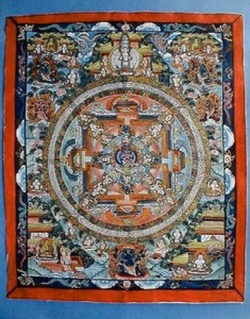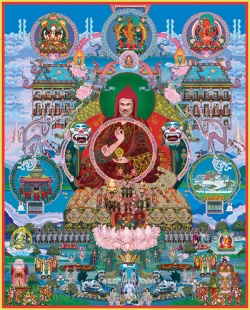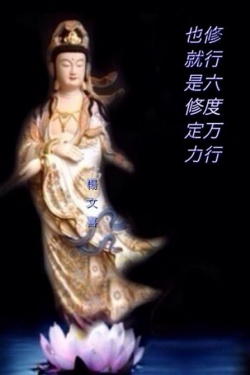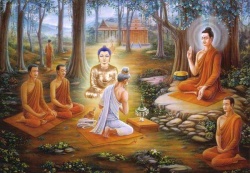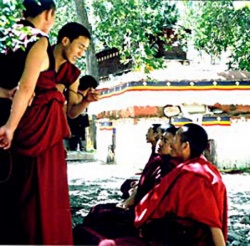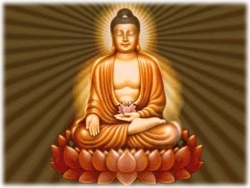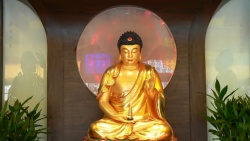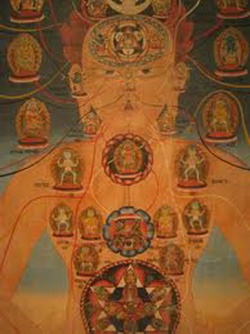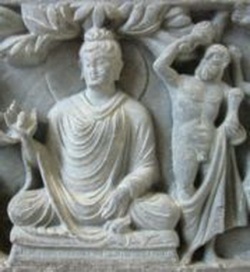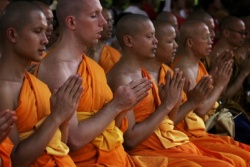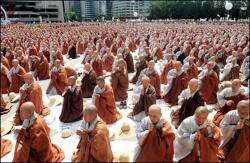Difference between revisions of "Mantra"
| (9 intermediate revisions by 4 users not shown) | |||
| Line 1: | Line 1: | ||
| − | [[File:Picture 4.JPG|thumb|250px|]] | + | [[File:Picture 4.JPG|thumb|250px|]]<nomobile>{{DisplayImages|4541|4002|4025|1089|3820|2257|1503|42|1514|3606|3580|1138|1795|1472|582|4021|4006|3347}}</nomobile> |
| + | |||
| + | |||
| + | |||
| + | |||
| + | |||
| + | |||
| + | |||
| + | |||
<poem> | <poem> | ||
| − | A [[mantra]] is a [[sound]], syllable, [[word]], or group of words that is considered capable of "creating [[transformation]]" (cf. [[spiritual]] [[transformation]]). Its use and type varies according to the school and [[philosophy]] associated with the [[mantra]]. | + | A [[mantra]] is a [[sound]], {{Wiki|syllable}}, [[word]], or group of words that is considered capable of "creating [[transformation]]" (cf. [[spiritual]] [[transformation]]). |
| + | Its use and type varies according to the school and [[philosophy]] associated with the [[mantra]]. | ||
| − | [[Mantras]] (Devanāgarī मन्त्र) originated in the {{Wiki|Vedic}} [[tradition]] of [[India]], becoming an [[essential]] part of the [[Hindu]] [[tradition]] and a customary practice within [[Buddhism]], {{Wiki|Sikhism}}, and [[Jainism]]. | + | [[Mantras]] ([[Devanāgarī]] {{SanskritBig|[[मन्त्र]]}}) originated in the {{Wiki|Vedic}} [[tradition]] of [[India]], becoming an [[essential]] part of the [[Hindu]] [[tradition]] and a customary practice within [[Buddhism]], {{Wiki|Sikhism}}, and [[Jainism]]. |
| − | In the context of the [[Vedas]], the term [[mantra]] refers to the entire portion which contains the texts called Rig, Yajur or [[Sama]], that is, the metrical part as opposed to the prose [[Brahmana]] commentary | + | In the context of the [[Vedas]], the term [[mantra]] refers to the entire portion which contains the texts called Rig, [[Yajur]] or [[Sama]], that is, the metrical part as opposed to the prose [[Brahmana]] commentary. |
| − | + | With the transition from [[ritualistic]] {{Wiki|Vedic}} [[traditions]] to [[mystical]] and {{Wiki|egalitarian}} [[Hindu]] schools of [[Yoga]], [[Vedanta]], [[Tantra]] and [[Bhakti]], the {{Wiki|orthodox}} [[attitude]] of the {{Wiki|elite}} [[nature]] of [[mantra]] [[knowledge]] gave way to [[spiritual]] interpretations of [[mantras]] as a translation of the [[human]] will or [[desire]] into a [[form]] of [[action]]. | |
| − | + | For the authors of the {{Wiki|Hindu scriptures}} of the [[Upanishads]], the {{Wiki|syllable}} Om, itself constituting a [[mantra]], represents [[Brahman]], the godhead, as well as the whole of creation. | |
| − | + | [[Kūkai]] suggests that all {{Wiki|sounds}} are the [[voice of the Dharmakaya Buddha]] — i.e. as in [[Hindu]] [[Upanishadic]] and [[Yogic]] [[thought]], these {{Wiki|sounds}} are [[manifestations of ultimate reality]], in the [[sense]] of [[sound]] [[symbolism]] postulating that the {{Wiki|vocal}} {{Wiki|sounds}} of the [[mantra]] have [[inherent]] meaning {{Wiki|independent}} of the [[understanding]] of the [[person]] uttering them. | |
| − | Khanna (2003: p. 21) links [[mantras]] and [[yantras]] to | + | Nevertheless, such [[understanding]] of what a [[mantra]] may [[symbolize]] or how it may [[function]] differs throughout the various [[traditions]] and also depends on the context in which it is written or sounded. |
| + | |||
| + | In some instances there are multiple layers of [[symbolism]] associated with each [[sound]], many of which are specific to particular schools of [[thought]]. For an example of such see the {{Wiki|syllable}}: [[Om]] which is central to both [[Hindu]] and [[Buddhist traditions]]. | ||
| + | |||
| + | |||
| + | While [[Hindu]] [[tantra]] eventually came to see the letters as well as the {{Wiki|sounds}} as representatives of the [[divine]], the shift toward [[writing]] occurred when [[Buddhism]] traveled to [[China]]. | ||
| + | |||
| + | Although [[China]] lacked a unifying, ecclesiastic [[Language]] like [[Sanskrit]], [[China]] achieved its {{Wiki|cultural}} {{Wiki|unity}} through a written [[Language]] with characters that were flexible in pronunciation but more precise in meaning. | ||
| + | |||
| + | The {{Wiki|Chinese}} prized written [[Language]] much more highly than did the [[Indian]] [[Buddhist]] [[missionaries]], and the [[writing]] of [[mantras]] became a [[spiritual]] practice in its [[own]] right. | ||
| + | |||
| + | So that whereas [[Brahmins]] had been very strict on correct pronunciation, the {{Wiki|Chinese}}, and indeed other Far-Eastern [[Buddhists]] were less concerned with this than correctly [[writing]] something down. | ||
| + | |||
| + | The practice of [[writing]] [[mantras]], and copying texts as a [[spiritual]] practice, became very refined in [[Japan]], and the [[writing]] in the [[Siddham]] [[script]] in which the [[Sanskrit]] of many [[Buddhist Sutras]] were written is only really seen in [[Japan]] nowadays. | ||
| + | |||
| + | However, written mantra-repetition in [[Hindu]] practices, with [[Sanskrit]] in any number of scripts, is well-known to many sects in [[India]] as well. | ||
| + | |||
| + | |||
| + | [[Khanna]] (2003: p. 21) links [[mantras]] and [[yantras]] to [[thought forms]]: | ||
[[File:Gns.jpg|thumb|250px|]] | [[File:Gns.jpg|thumb|250px|]] | ||
| − | [[Mantras]], the [[Sanskrit]] syllables inscribed on [[yantras]], are [[essentially]] '[[thought | + | [[Mantras]], the [[Sanskrit]] {{Wiki|syllables}} inscribed on [[yantras]], are [[essentially]] '[[thought forms]]' representing [[divinities]] or [[cosmic powers]], which exert their influence by means of sound-vibrations |
| + | |||
{{Wiki|Etymology}} | {{Wiki|Etymology}} | ||
| − | |||
| − | An Indo-Iranian *[[mantra]] is also preserved in [[Avestan]] manthra, effectively meaning "[[word]]" but with far-reaching implications: Manthras are inherently "true" (aša), and the proper recitation of them brings about (realizes) what is inherently true in them | + | The [[Sanskrit]] [[word]] [[mantra]]- (m.; also n. [[mantram]]) consists of the [[root]] [[man]]- "to think" (also in [[manas]] "[[mind]]") and the suffix -'tra', designating tools or instruments, hence a literal translation would be "instrument of [[thought]]". |
| + | |||
| + | An [[Indo-Iranian]] *[[mantra]] is also preserved in [[Avestan]] 'manthra', effectively meaning "[[word]]" but with far-reaching implications: [[Manthras]] are inherently "true" ([[aša]]), and the proper {{Wiki|recitation}} of them brings about (realizes) what is inherently true in them. | ||
| − | + | It may then be said that [[manthras]] are both an expression of being and "right working" and the {{Wiki|recitation}} of them is crucial to the maintenance of order and being. | |
| − | + | [[Indo-Iranian]] *[[sātyas]] [[mantras]] ([[Yasna]] 31.6: haiθīm mathrem) thus "does not simply mean 'true [[Word]]' but formulated [[thought]] which is in conformity with the [[reality]]' or '{{Wiki|poetic}} ([[religious]]) [[formula]] with [[inherent]] fulfillment ([[realization]]).'" | |
| − | The {{Wiki|Chinese}} translation is [[zhenyan]] 眞言, [[真言]], literally "true words", the [[Japanese]] on'yomi reading of the {{Wiki|Chinese}} being [[shingon]] (which is also used as the proper [[name]] for the prominent [[esoteric]] [[Shingon]] sect). | + | {{Wiki|Latin}} [[word]] {{Wiki|Mentor}} (also in its usage in English and other [[languages]]) is a {{Wiki|cognate}} (cf. Mens [[sana]] in corpore sano = Healthy [[mind]] in a healthy [[Body]]), as is the [[root]] preserved in most Slavonic [[languages]] as Mądr-/Mudr-, for [[Wisdom]] and [[Sage]], cf. {{Wiki|Russian}} Mudrec. |
| + | |||
| + | The {{Wiki|Chinese}} translation is [[zhenyan]] [[眞言]], [[真言]], literally "[[true words]]", the [[Japanese]] [[on'yomi]] reading of the {{Wiki|Chinese}} being [[shingon]] (which is also used as the proper [[name]] for the prominent [[esoteric]] [[Shingon]] [[sect]]). | ||
[[Mantra]] in non-[[Esoteric Buddhism]] | [[Mantra]] in non-[[Esoteric Buddhism]] | ||
[[File:Gold.jpg|thumb|250px|]] | [[File:Gold.jpg|thumb|250px|]] | ||
| − | In [[Buddhism in China]] and [[Vietnam]], ten small [[mantras]] were finalized by the [[Monk]] Yulin (玉琳國師), a [[teacher]] of the {{Wiki|Shunzhi Emperor}} for [[monks]], [[nuns]], and laity to [[chant]] in the morning. | + | In [[Buddhism in China]] and [[Vietnam]], ten small [[mantras]] were finalized by the [[Monk]] [[Yulin]] ([[玉琳國師]]), a [[teacher]] of the {{Wiki|Shunzhi Emperor}} for [[monks]], [[nuns]], and laity to [[chant]] in the morning. |
| − | Along with the ten [[mantras]], the [[Great Compassion Mantra]], [[The Shurangama Mantra]] of the [[Shurangama]], [[Heart | + | Along with the ten [[mantras]], the [[Great Compassion Mantra]], [[The Shurangama Mantra]] of the [[Shurangama]], [[Heart Sutra]] and various [[forms]] of [[nianfo]] are also chanted. |
| + | |||
| + | |||
| + | [[The [[Shurangama Mantra]] may be the longest [[mantra]]. | ||
| − | |||
There are [[Thai]] [[buddhist]] [[amulet]] [[katha]]. | There are [[Thai]] [[buddhist]] [[amulet]] [[katha]]. | ||
| + | |||
[[Mantra]] in [[Shingon Buddhism]] | [[Mantra]] in [[Shingon Buddhism]] | ||
| − | |||
| − | The [[word]] [[dharani]] derives from a [[Sanskrit]] [[root]] dh.r which means to hold or maintain. Ryuichi Abe suggests that it is generally understood as a mnemonic device which encapsulates the meaning of a section or chapter of a [[Sutra]]. [[Dharanis]] are also considered to {{Wiki|protect}} the one who [[chants]] them from {{Wiki|malign}} [[influences]] and {{Wiki|calamities}}. | + | [[Kūkai]] (774-835), a noted [[Buddhist monk]], advanced a general {{Wiki|theory}} of [[Language]] based on his analysis of two [[forms]] of [[Buddhist]] [[ritual]] [[Language]]: |
| + | |||
| + | [[dharani]] ([[dhāra.nī]]) and [[mantra]]. | ||
| + | |||
| + | [[Mantra]] is restricted to [[esoteric]] [[Buddhist practice]] whereas [[dharani]] is found in both [[esoteric]] and [[exoteric]] [[ritual]]. | ||
| + | |||
| + | [[Dharanis]] for instance are found in [[The Heart Sutra]]. | ||
| + | |||
| + | The term "[[shingon]]" (lit. [[true word]]) is the [[Japanese]] pronunciation of the {{Wiki|Chinese}} term for [[mantra]], [[chen yen]]. | ||
| + | |||
| + | |||
| + | The [[word]] [[dharani]] derives from a [[Sanskrit]] [[root]] dh.r which means to hold or maintain. | ||
| + | |||
| + | [[Ryuichi Abe]] suggests that it is generally understood as a {{Wiki|mnemonic}} device which encapsulates the meaning of a section or [[chapter]] of a [[Sutra]]. | ||
| + | |||
| + | [[Dharanis]] are also considered to {{Wiki|protect}} the one who [[chants]] them from {{Wiki|malign}} [[influences]] and {{Wiki|calamities}}. | ||
| + | |||
| + | |||
| + | The term [[mantra]] is [[traditionally]] said to be derived from two [[roots]]: '[[man]]', to think; and the action-oriented suffix -'tra'. | ||
| + | |||
| + | Thus a [[mantra]] can be considered to be a {{Wiki|linguistic}} device for deepening ones [[thought]], or in the [[Buddhist]] context for developing the [[enlightened mind]]. | ||
| + | |||
| + | However, it is also true that [[mantras]] have been used as [[magic]] {{Wiki|spells}} for very [[mundane]] purposes such as [[attaining]] [[wealth]] and long [[Life]], and eliminating enemies. | ||
| + | |||
| + | In daily living, many [[thought]] the pronunciation of the [[mantra]] was not important to take its effect and the expected effect may not happen because of fixed [[Karma]] ([[定業]]), or because there appears a better way to solve the situation. | ||
| + | |||
| + | |||
| + | The {{Wiki|distinction}} between [[dharani]] and [[mantra]] is difficult to make. We can say that all [[mantras]] are [[dharanis]] but that not all [[dharanis]] are [[mantras]]. [[Mantras]] do tend to be shorter. | ||
| − | + | Both tend to contain a number of unintelligible phonic fragments such as Om, or Hu.m, which is perhaps why some [[people]] consider them to be [[essentially]] meaningless. | |
| − | + | [[Kūkai]] made [[mantra]] a special class of [[dharani]] which showed that every {{Wiki|syllable}} of a [[dharani]] was a [[manifestation]] of the [[true nature of reality]] – in [[Buddhist]] terms that all [[sound]] is a [[manifestation]] of [[Shunyata]] or [[Emptiness]] of [[self-nature]]. | |
| + | |||
| + | Thus rather than being devoid of meaning, [[Kūkai]] suggests that [[dharanis]] are in fact saturated with meaning – every {{Wiki|syllable}} is [[symbolic]] on multiple levels. | ||
[[File:Goldenbuddha.jpg|thumb|250px|]] | [[File:Goldenbuddha.jpg|thumb|250px|]] | ||
| − | |||
| − | |||
| − | In this system of [[thought]] all {{Wiki|sounds}} are said to originate from "a" – which is the short a [[sound]] in father. For [[Esoteric Buddhism]] "a" has a special [[function]] because it is associated with [[Shunyata]] or the [[idea]] that no thing [[exists]] in its own right, but is contingent upon [[causes]] and [[conditions]]. (See [[Dependent origination]]) In [[Sanskrit]] "a" is a prefix which changes the meaning of a [[word]] into its opposite, so "[[vidya]]" is [[understanding]], and "[[Avidya]]" is [[Ignorance]] (the same arrangement is also found in many {{Wiki|Greek}} words, like e.g. "{{Wiki|atheism}}" vs. "[[theism]]" and "apathy" vs. "pathos"). The [[letter]] a is both visualised in the [[Siddham]] script, and pronounced in [[rituals]] and [[meditation practices]]. In the [[Mahavairocana | + | One of [[Kūkai's]] {{Wiki|distinctive}} contributions was to take this [[symbolic]] association even further by saying that there is no [[essential]] difference between the {{Wiki|syllables}} of [[mantras]] and [[sacred]] texts, and those of ordinary [[Language]]. |
| + | |||
| + | If one understood the workings of [[mantra]], then any {{Wiki|sounds}} could be a representative of [[ultimate reality]]. | ||
| + | |||
| + | This {{Wiki|emphasis}} on {{Wiki|sounds}} was one of the drivers for [[Kūkai's]] championing of the phonetic [[writing]] system, the [[kana]], which was adopted in [[Japan]] around the [[time]] of [[Kūkai]]. | ||
| + | |||
| + | He is generally credited with the invention of the [[kana]], but there is apparently some [[Doubt]] about this story amongst [[scholars]]. | ||
| + | |||
| + | |||
| + | |||
| + | This [[mantra]]-based {{Wiki|theory}} of [[Language]] had a powerful effect on [[Japanese]] [[thought]] and {{Wiki|society}} which up until [[Kūkai's]] [[time]] had been dominated by imported {{Wiki|Chinese culture}} of [[thought]], particularly in the [[form]] of the Classical {{Wiki|Chinese}} [[Language]] which was used in the court and among the literati, | ||
| + | |||
| + | and [[Wikipedia:Confucianism|Confucianism]] which was the dominant {{Wiki|political}} ideology. In particular [[Kūkai]] was able to use this new {{Wiki|theory}} of [[Language]] to create links between indigenous [[Japanese]] {{Wiki|culture}} and [[Buddhism]]. | ||
| + | |||
| + | For instance, he made a link between The [[Buddha]] [[Mahavairocana]] and the [[Shinto]] [[sun Goddess]] {{Wiki|Amaterasu}}. | ||
| + | |||
| + | Since the [[emperors]] were [[thought]] to be descended [[form]] {{Wiki|Amaterasu}}, | ||
| + | |||
| + | [[Kūkai]] had found a powerful [[connection]] here that linked the [[emperors]] with The [[Buddha]], and also in finding a way to integrate [[Shinto]] with [[Buddhism]], something that had not happened with [[Wikipedia:Confucianism|Confucianism]]. | ||
| + | |||
| + | [[Buddhism]] then became [[essentially]] an indigenous [[religion]] in a way that [[Wikipedia:Confucianism|Confucianism]] had not. | ||
| + | |||
| + | And it was through [[Language]], and [[mantra]] that this [[connection]] was made. | ||
| + | |||
| + | [[Kūkai]] helped to elucidate what [[mantra]] is in a way that had not been done before: he addresses the fundamental questions of what a text is, how [[signs]] [[function]], and above all, what [[Language]] is. | ||
| + | |||
| + | In this he covers some of the same ground as {{Wiki|modern}} day Structuralists and others [[scholars]] of [[Language]], although he comes to very different conclusions. | ||
| + | |||
| + | |||
| + | In this system of [[thought]] all {{Wiki|sounds}} are said to originate from "a" – which is the short a [[sound]] in father. | ||
| + | |||
| + | For [[Esoteric Buddhism]] "a" has a special [[function]] because it is associated with [[Shunyata]] or the [[idea]] that no thing [[exists]] in its [[own]] right, but is contingent upon [[causes]] and [[conditions]]. | ||
| + | |||
| + | (See [[Dependent origination]]) | ||
| + | |||
| + | In [[Sanskrit]] "a" is a prefix which changes the meaning of a [[word]] into its opposite, so "[[vidya]]" is [[understanding]], and "[[Avidya]]" is [[Ignorance]] (the same arrangement is also found in many {{Wiki|Greek}} words, like e.g. "{{Wiki|atheism}}" vs. "[[theism]]" and "{{Wiki|apathy}}" vs. "[[pathos]]"). | ||
| + | |||
| + | The [[letter]] a is both [[visualised]] in the [[Siddham]] [[script]], and pronounced in [[rituals]] and [[meditation practices]]. | ||
| + | |||
| + | In the [[Mahavairocana Sutra]] which is central to [[Shingon Buddhism]] it says: Thanks to the [[original vows]] of the [[Buddhas]] and [[Bodhisattvas]], a miraculous force resides in the [[mantras]], so that by pronouncing them one acquires [[merit]] without limits". [in {{Wiki|Conze}}, p. 183] | ||
| + | |||
[[Mantra]] in Indo-[[Tibetan Buddhism]] | [[Mantra]] in Indo-[[Tibetan Buddhism]] | ||
[[File:14-s.jpg|thumb|250px|]] | [[File:14-s.jpg|thumb|250px|]] | ||
| − | [[Mantrayana]] ([[Sanskrit]]), that may be rendered as "way of [[mantra]]", was the original self-identifying [[name]] of those that have come to be determined '[[Nyingmapa]]'. The [[Nyingmapa]] which may be rendered as "those of the {{Wiki|ancient}} way", a [[name]] [[constructed]] due to the genesis of the [[Sarma]] "fresh", "new" [[traditions]]. [[Mantrayana]] has developed into a {{Wiki|synonym}} of [[Vajrayana]]. | + | [[Mantrayana]] ([[Sanskrit]]), that may be rendered as "way of [[mantra]]", was the original self-identifying [[name]] of those that have come to be determined '[[Nyingmapa]]'. |
| + | |||
| + | The [[Nyingmapa]] which may be rendered as "those of the {{Wiki|ancient}} way", a [[name]] [[constructed]] due to the genesis of the [[Sarma]] "fresh", "new" [[traditions]]. | ||
| + | |||
| + | [[Mantrayana]] has developed into a {{Wiki|synonym}} of [[Vajrayana]]. | ||
| + | |||
| + | Noted [[translator]] of [[Buddhist texts]] {{Wiki|Edward Conze}} (1904–1979) distinguishes [[three periods]] in the [[Buddhist]] use of [[mantra]]. | ||
| + | |||
| + | Initially, according to {{Wiki|Conze}}, like their fellow {{Wiki|Indians}}, [[Buddhists]] used [[mantra]] as [[protective]] {{Wiki|spells}} to ward off {{Wiki|malign}} [[influences]]. | ||
| + | |||
| + | Despite a [[Vinaya]] {{Wiki|rule}} which forbids [[monks]] engaging in the {{Wiki|Brahminical}} practice of [[Chanting]] [[mantras]] for material gain, there are a number of [[protective]] for a group of [[ascetic]] [[monks]]. | ||
| + | |||
| + | However, even at this early stage, there is perhaps something more than {{Wiki|animistic}} [[magic]] at work. Particularly in the case of the [[Ratana]] [[Sutta]] the efficacy of the verses seems to be related to the {{Wiki|concept}} of "[[truth]]". | ||
| + | |||
| + | Each verse of the [[Sutta]] ends with "by the [[virtue]] of this [[truth]] may there be [[Happiness]]". | ||
| + | |||
| + | |||
| + | {{Wiki|Conze}} notes that later [[mantras]] were used more to guard the [[spiritual]] [[Life]] of the chanter, and [[sections]] on [[mantras]] began to be included in some [[Mahayana]] [[sutras]] such as the White [[Lotus Sutra]], and [[The Lankavatara Sutra]]. | ||
| + | |||
| + | The scope of [[protection]] also changed in this [[time]]. | ||
| + | |||
| + | In the [[Sutra]] of Golden [[Light]] the [[Four Great Kings]] promise to exercise {{Wiki|sovereignty}} over the different classes of [[demigods]], to {{Wiki|protect}} the whole of [[Jambudvipa]] (the [[India]] sub continent), to {{Wiki|protect}} [[monks]] who proclaim the [[Sutra]], and to {{Wiki|protect}} [[kings]] who patronise the [[monks]] who proclaim the [[Sutra]]. | ||
| + | |||
| + | The apotheosis of this type of approach is the [[Nichiren]] school of [[Buddhism]] that was founded in 13th century [[Japan]], and which distilled many previously complex [[Buddhist practices]] down to the veneration of the [[Lotus Sutra]] through {{Wiki|recitation}} of the [[Daimoku]]: "[[Nam myoho renge kyo]]" which translates as "[[Homage to the Lotus Sutra]]". | ||
| + | |||
| + | |||
| + | The third period began, according to {{Wiki|Conze}}, in about the 7th century, to take center stage and become a [[vehicle]] for {{Wiki|salvation}} in their [[own]] right. | ||
| + | |||
| + | [[Tantra]] started to gain momentum in the 6th and 7th century, with specifically [[Buddhist]] [[forms]] appearing as early as 300CE. | ||
| + | |||
| + | [[Mantrayana]] was an early [[name]] for the what is now more commonly known as [[Vajrayana]], which gives us a hint as to the place of [[mantra]] in Indo-[[Tibetan Buddhism]]. | ||
| + | |||
| + | |||
| + | |||
| + | ==[[Direct Experience Of Reality]]== | ||
| + | |||
| − | |||
| − | + | The aim of [[Vajrayana practice]] is to give the [[practitioner]] a [[direct experience of reality]], of things as they really are. | |
| + | |||
| + | [[Mantras]] [[function]] as [[symbols]] of that [[reality]], and different [[mantras]] are different aspects of that [[reality]] – for example [[Wisdom]] or [[Compassion]]. | ||
| + | |||
| + | [[Mantras]] are often associated with a particular [[deity]], one famous exception being the [[Prajnaparamita]] [[mantra]] associated with [[The Heart Sutra]]. | ||
| + | |||
| + | |||
| + | One of the key [[Vajrayana]] strategies for bringing about a direct [[experience]] of [[reality]] is to engage the entire [[psycho-physical]] {{Wiki|organism}} in the practices. | ||
| + | |||
| + | In one [[Buddhist]] analysis the [[person]] consists of '[[Body]], [[speech]] and [[mind]]' (refer: | ||
| + | |||
| + | |||
| + | |||
| + | Three [[Vajra]]). | ||
| + | |||
| + | |||
| + | So a typical [[sadhana]] or [[meditation practice]] might include [[mudras]], or [[symbolic]] [[hand gestures]]; the [[recitations]] of [[mantras]]; as well as the [[visualisation]] of [[celestial]] [[beings]] and [[visualising the letters of the mantra]] which is being recited. | ||
| + | |||
| + | Clearly here [[mantra]] is associated with [[speech]]. | ||
| + | |||
| + | The [[meditator]] may [[visualize]] the letters in front of themselves, or within their [[Body]]. They may be pronounced out loud, or internally in the [[mind only]]. | ||
| − | |||
| − | |||
[[Om mani padme hum]] | [[Om mani padme hum]] | ||
| − | + | ||
| − | + | ||
[[File:175p.JPG|thumb|250px|]] | [[File:175p.JPG|thumb|250px|]] | ||
| − | |||
| − | The [[book]] Foundations of [[Tibetan]] [[Mysticism]] by [[Lama]] [[Anagarika]] | + | Probably the most famous [[mantra]] of [[Buddhism]] is [[Om mani padme hum]], the six {{Wiki|syllable}} [[mantra]] of the [[Bodhisattva of Compassion]] [[Avalokiteśvara]] ([[Tibetan]]: [[Chenrezig]], {{Wiki|Chinese}}: [[Guanyin]]). |
| + | |||
| + | This [[mantra]] is particularly associated with the [[four-armed Shadakshari]] [[form of Avalokiteśvara]]. | ||
| + | |||
| + | The [[Dalai Lama]] is said to be an [[incarnation]] of [[Avalokiteshvara]], and so the [[mantra]] is especially revered by his {{Wiki|devotees}}. | ||
| + | |||
| + | |||
| + | The [[book]] Foundations of [[Tibetan]] [[Mysticism]] by [[Lama]] [[Anagarika Govinda]], gives a classic example of how such a [[mantra]] can contain many levels of [[symbolic]] meaning. | ||
| + | |||
| + | [[Donald Lopez]] gives a good [[discussion]] of this [[mantra]] and its various interpretations in his [[book]] Prisoners of [[Shangri-La]]: [[Tibetan Buddhism]] and the [[West]]. | ||
| + | |||
| + | [[Lopez]] is an authoritative writer and challenges the stereotypical analysis of the [[mantra]] as meaning "The [[Jewel]] in the [[Lotus]]", an [[interpretation]] that is not supported by either a {{Wiki|linguistic}} analysis, nor by [[Tibetan tradition]], and is symptomatic of the {{Wiki|Western}} [[Orientalist]] approach to the 'exotic' [[East]]. | ||
| + | |||
| + | |||
| + | He suggests that [[Manipadma]] is actually the [[name]] of a [[Bodhisattva]], a [[form of Avalokiteshvara]] who has many other names in any case [[including]] [[Padmapani]] or [[Lotus flower]] in hand. | ||
| + | |||
| + | The {{Wiki|Brahminical}} insistence on absolutely correct pronunciation of [[Sanskrit]] broke down as [[Buddhism]] was exported to other countries where the inhabitants found it impossible to reproduce the {{Wiki|sounds}}. | ||
| + | |||
| + | So in [[Tibet]], for instance, where this [[mantra]] is on the lips of many [[Tibetans]] all their waking hours, the [[mantra]] is pronounced [[Om mani peme hum]]. | ||
| + | |||
| − | |||
Some other [[mantras]] in [[Tibetan Buddhism]] | Some other [[mantras]] in [[Tibetan Buddhism]] | ||
| − | |||
| − | Please note that the [[word]] swaha is sometimes shown as [[svaha]], and is usually pronounced as 'so-ha' by [[Tibetans]]. Spellings tend to vary in the transliterations to English, for example, [[hum]] and hung are generally the same [[word]]. The [[mantras]] used in [[Tibetan Buddhist]] practice are in [[Sanskrit]], to preserve the original [[mantras]]. [[Visualizations]] and other practices are usually done in the [[Tibetan | + | |
| + | The following list of [[mantras]] is from [[Kailash]] - [[Journal of Himalayan Studies]], Volume 1, Number 2, 1973. (pp. 168–169) (augmented by other contributors). It also includes renderings of [[Om mani padme hum]]. | ||
| + | |||
| + | |||
| + | Please note that the [[word]] [[swaha]] is sometimes shown as [[svaha]], and is usually pronounced as '[[so-ha]]' by [[Tibetans]]. Spellings tend to vary in the transliterations to English, for example, [[hum]] and [[hung]] are generally the same [[word]]. | ||
| + | |||
| + | The [[mantras]] used in [[Tibetan Buddhist]] practice are in [[Sanskrit]], to preserve the original [[mantras]]. | ||
| + | |||
| + | [[Visualizations]] and other practices are usually done in the [[Tibetan Language]]. | ||
[[File:Graph2.jpg|thumb|250px|]] | [[File:Graph2.jpg|thumb|250px|]] | ||
| − | Om [[vagishvara]] [[hum]] This is the [[mantra]] of the [[Mahabodhisattva]] [[Manjusri]], [[Tibetan]]: Jampelyang (Wylie "'jam dpal dbyangs")... The [[Buddha]] in his [[Wisdom]] aspect. | + | |
| − | [[Om mani padme hum]] The [[mantra | + | |
| − | Om [[Vajrapani]] [[hum]] The [[mantra]] of The [[Buddha]] as [[Protector]] of the [[Secret Teachings]]. i.e.: as the [[Mahabodhisattva]] [[Channa Dorje]] ([[Vajrapani]]). | + | |
| − | Om [[Vajrasattva]] [[hum]] The short [[mantra]] for | + | |
| − | + | Om [[vagishvara]] [[hum]] This is the [[mantra]] of the [[Mahabodhisattva]] [[Manjusri]], [[Tibetan]]: [[Jampelyang]] ([[Wylie]] "'[[jam dpal]] dbyangs")... The [[Buddha]] in his [[Wisdom]] aspect. | |
| − | Om tare tuttare ture mama ayurjnana punye pushting [[svaha]] The [[mantra]] | + | |
| + | [[Om mani padme hum]] - The [[mantra of Avalokitesvara]], [[Mahabodhisattva]], The [[Buddha]] in his [[Compassion]] aspect. | ||
| + | |||
| + | Om [[Vajrapani]] [[hum]] - The [[mantra]] of The [[Buddha]] as [[Protector]] of the [[Secret Teachings]]. i.e.: as the [[Mahabodhisattva]] [[Channa Dorje]] ([[Vajrapani]]). | ||
| + | |||
| + | Om [[Vajrasattva]] [[hum]] - The short [[mantra]] for [[White Vajrasattva]], there is also a full [[100-syllable mantra]] for [[Vajrasattva]]. | ||
| + | |||
| + | [[Om ah hum vajra Guru padma Siddhi hum]] - The [[mantra]] of the [[Vajraguru]] [[Guru]] [[Padma Sambhava]] who established [[Mahayana Buddhism]] and [[Tantra]] in [[Tibet]]. | ||
| + | |||
| + | Om tare tuttare ture mama ayurjnana punye pushting [[svaha]] - The [[mantra of Dölkar]] or [[White Tara]], the [[emanation of Arya Tara]] [Chittamani [[Tara]]). | ||
| + | |||
| + | Variants: Om tare tuttare ture mama ayurjnana punye pushting [[kuru]] [[swaha]] ([[Drikung Kagyu]]), Om tare tuttare ture mama ayu punye [[jnana]] puktrim [[kuru]] soha ([[Karma Kagyu]]). | ||
| + | |||
Menu | Menu | ||
| − | |||
| − | |||
| − | Om tare tuttare ture [[svaha]], [[mantra]] of | + | [[Om Tare Tutare Ture Soha]]. |
| + | |||
| + | Om tare tuttare ture [[svaha]], [[mantra]] of [[Green]] [[Arya Tara]] - [[Jetsun Dolma]] or [[Tara]], the [[Mother of the Buddhas]]: om represents [[Tara]]'s [[sacred]] [[Body]], [[speech]], and [[mind]]. | ||
| + | |||
| + | Tare means liberating from all {{Wiki|discontent}}. | ||
| + | |||
| + | 'Tutare' means 'liberating from the eight {{Wiki|fears}}, the external dangers, but mainly from the internal dangers, the [[delusions]]. | ||
| + | |||
| + | 'Ture' means liberating from [[duality]]; it shows the "true" [[cessation]] of {{Wiki|confusion}}. | ||
| + | |||
| + | 'Soha' means "may the meaning of the [[mantra]] take [[root]] in my [[mind]]." | ||
| + | |||
| + | |||
| + | According to [[Tibetan Buddhism]], this [[mantra]] ([[Om tare tutare ture soha]]) can not only eliminate {{Wiki|disease}}, troubles, {{Wiki|disasters}}, and [[Karma]], but will also bring believers [[blessings]], longer [[Life]], and even the [[Wisdom]] to transcend one's circle of [[Reincarnation]]. [[Tara]] representing long [[Life]] and [[health]]. | ||
| + | |||
| + | |||
| + | [[oṃ]] amaraṇi jīvantaye [[svāhā]] ([[Tibetan]] version: [[oṃ]] ā ma ra ṇi [[dzi]] wan te ye svā hā) - The [[mantra]] of The [[Buddha]] of {{Wiki|limitless}} [[Life]]: The [[Buddha]] [[Amitayus]] ([[Tibetan]] [[Tsépagmed]]) in [[celestial]] [[form]]. | ||
| + | |||
| + | |||
| + | Om dhrung [[svaha]] - The [[purification]] [[mantra]] of the mother [[Namgyalma]]. | ||
| + | |||
| + | Om ami dhewa [[Hri]] - The [[mantra]] of The [[Buddha]] [[Amitabha]] (Hopagmed) of the [[Western Pureland]], his {{Wiki|skin}} the {{Wiki|colour}} of the setting {{Wiki|sun}}. | ||
| + | |||
| + | Om ami [[dewa]] [[Hri]] - The [[mantra]] of [[Amitabha]] (Ompagme in [[Tibetan]]). | ||
| + | |||
| + | Om [[ah]] ra pa ca na [[dhih]] - The [[mantra]] of the "sweet-voiced one", [[Jampelyang]] ([[Wylie]] "'[[jam dpal]] dbyangs") or [[Manjusri]], the [[Bodhisattva]] of [[Wisdom]]. | ||
| + | |||
| + | Om muni muni [[maha]] muniye [[sakyamuni]] [[swaha]] - The [[mantra]] of [[Buddha]] [[Sakyamuni]], the [[historical Buddha]] | ||
| − | + | Om gate gate [[paragate]] [[parasamgate]] [[Bodhi]] [[svaha]] - The [[mantra]] of the [[Heart]] of the [[Perfection]] of [[Wisdom]] [[Sutra]] ([[Heart]] [[Sutra]]) | |
| − | + | [[Namo]] bhagavate [[Bhaishajya]]-[[Guru]] vaidurya-praba-rajaya tathagataya arhate samyak-sambuddhaya tadyata * Tadyata [[OM]] bhaishajye bhaishajye [[maha]] [[bhaishajya]] raja-samudgate [[svaha]] - The [[mantra]] of the '[[Medicine]] [[Buddha]]', from {{Wiki|Chinese}} translations of the [[Master]] of [[Healing]] [[Sutra]]. | |
| − | |||
| − | |||
| − | |||
| − | |||
| − | |||
| − | |||
| − | [[Namo]] bhagavate [[Bhaishajya]]-[[Guru]] vaidurya-praba-rajaya tathagataya arhate samyak-sambuddhaya tadyata *Tadyata OM bhaishajye bhaishajye [[maha]] [[bhaishajya]] raja-samudgate [[svaha]] The [[mantra]] of the '[[Medicine]] [[Buddha]]', from {{Wiki|Chinese}} translations of the [[Master]] of [[Healing]] [[Sutra]]. | ||
[[File:Guides.jpg|thumb|250px|]] | [[File:Guides.jpg|thumb|250px|]] | ||
| + | |||
There are [[mantras]] in [[Bön]] and some {{Wiki|Chinese}} sects. | There are [[mantras]] in [[Bön]] and some {{Wiki|Chinese}} sects. | ||
[[Mantras]] in other sects and [[religions]] | [[Mantras]] in other sects and [[religions]] | ||
| − | [[Nam Myōhō Renge Kyō]] The [[mantra]] of the [[Nichiren]] [[Buddhism]]. | + | |
| − | Ná Mó Běn Shī Dà Zì Zai Wáng Fó (南無本師大自在王佛) The [[mantra]] of the [[Buddhayana]] sect (佛乘宗). | + | [[Nam Myōhō Renge Kyō]] - The [[mantra]] of the [[Nichiren]] [[Buddhism]]. |
| − | Námó Tiānyuán Tàibǎo Āmítuófó (南無天元太保阿彌陀佛) The [[mantra]] of the Way of Former [[Heaven]] and the T'ung-shan She. | + | |
| − | + | [[Ná Mó Běn Shī Dà Zì Zai Wáng Fó]] ([[南無本師大自在王佛]]) - The [[mantra]] of the [[Buddhayana]] [[sect]] (佛乘宗). | |
| − | Zhēnkōngjiāxiàng, wúshēngfùmǔ ( | + | |
| − | Gomtrazan.Gwaarla.Rarunka.Sohuan.Satnum The [[mantra]] of Ching Hai. | + | [[Námó Tiānyuán Tàibǎo Āmítuófó]] ([[南無天元太保阿彌陀佛]]) - The [[mantra]] of the Way of Former [[Heaven]] and the T'ung-shan She. |
| − | Zhōngshùliánmíngdé, zhèngyìxìnrěngōng, bóxiàoréncíjiào, jiéjiǎnzhēnlǐhé (忠恕廉明德、正義信忍公、博孝仁慈覺、節儉真禮和) The [[mantra]] of the Tiender and the [[Lord | + | [[Guān Shì Yīn Pú Sà]] ([[觀世音菩薩]]) The [[mantra]] of the Li-ism |
| − | Qīngjìng guāngmíng dàlì zhìhuì wúshàng zhìzhēn móní guāngfó (清淨光明大力智慧無上至真摩尼光佛) The [[mantra]] of the {{Wiki|Manichaeism}} in [[China]] | + | |
| + | [[Zhēnkōngjiāxiàng, wúshēngfùmǔ]] ([[真空家鄉]],[[無生父母]]) - The [[mantra]] of the [[Luo Sect]] ([[羅教]]) | ||
| + | |||
| + | [[Gomtrazan.Gwaarla.Rarunka.Sohuan.Satnum]] - The [[mantra]] of [[Ching Hai]]. | ||
| + | |||
| + | [[Zhōngshùliánmíngdé, zhèngyìxìnrěngōng, bóxiàoréncíjiào,]] jiéjiǎnzhēnlǐhé (忠恕廉明德、正義信忍公、博孝仁慈覺、節儉真禮和) - The [[mantra]] of the [[Tiender]] and the [[Lord of Universe]] {{Wiki|Church}} | ||
| + | |||
| + | [[Qīngjìng guāngmíng dàlì zhìhuì wúshàng zhìzhēn móní guāngfó]] ([[清淨光明大力智慧無上至真摩尼光佛]]) The [[mantra]] of the {{Wiki|Manichaeism}} in [[China]] | ||
Collection | Collection | ||
| − | The [[mantra]] in [[Chinese Buddhist canon]] are collected by {{Wiki|Qianlong Emperor}} into a [[book]]. Kuang-Ming Lin (林光明) amended it. | + | The [[mantra]] in [[Chinese Buddhist canon]] are collected by {{Wiki|Qianlong Emperor}} into a [[book]]. [[Kuang-Ming Lin]] ([[林光明]]) amended it. |
[[Mantra]] in {{Wiki|Sikhism}} | [[Mantra]] in {{Wiki|Sikhism}} | ||
| − | In the {{Wiki|Sikh}} [[religion]], a mantar or [[mantra]] is a Shabad ([[Word]] or hymn) from the Adi Granth to [[concentrate]] the [[mind]] on [[God]] and the message of the ten {{Wiki|Sikh}} [[Gurus]]. | + | In the {{Wiki|Sikh}} [[religion]], a [[mantar]] or [[mantra]] is a [[Shabad]] ([[Word]] or hymn) from the [[Adi Granth]] to [[concentrate]] the [[mind]] on [[God]] and the message of the ten {{Wiki|Sikh}} [[Gurus]]. |
| + | |||
| + | [[Mantras]] in {{Wiki|Sikhism}} are fundamentally different from the [[secret mantras]] used in other [[religions]]. Unlike in other [[religions]], {{Wiki|Sikh}} [[mantras]] are open for anyone to use. | ||
| + | |||
| + | They are used openly and are not [[taught]] in secret sessions but are used in front of assemblies of {{Wiki|Sikhs}}. | ||
| + | |||
| + | The [[Mool Mantar]], the first composition of [[Guru Nanak]], is the most widely known {{Wiki|Sikh}} [[mantra]]. | ||
| − | |||
| − | |||
[[Mantra]] in {{Wiki|Taoism}} | [[Mantra]] in {{Wiki|Taoism}} | ||
| − | There are [[mantras]] in {{Wiki|Taoism}} such as the words in Dafan yinyu wuliang yin (大梵隱語無量音) and the [[Tibetan Buddhism]] [[mantra]] om (唵). | + | There are [[mantras]] in {{Wiki|Taoism}} such as the words in [[Dafan yinyu wuliang yin]] ([[大梵隱語無量音]]) and the [[Tibetan Buddhism]] [[mantra]] om ([[唵]]). |
| + | |||
| + | There are [[mantras]] in [[Cheondoism]], [[Daesun Jinrihoe]], [[Jeung San Do]] and [[Onmyōdō]]. | ||
| + | |||
| + | |||
| − | |||
</poem> | </poem> | ||
{{W}} | {{W}} | ||
[[Category:Buddhist Terms]] | [[Category:Buddhist Terms]] | ||
[[Category:Mantras]] | [[Category:Mantras]] | ||
Latest revision as of 19:03, 30 March 2023
A mantra is a sound, syllable, word, or group of words that is considered capable of "creating transformation" (cf. spiritual transformation).
Its use and type varies according to the school and philosophy associated with the mantra.
Mantras (Devanāgarī मन्त्र) originated in the Vedic tradition of India, becoming an essential part of the Hindu tradition and a customary practice within Buddhism, Sikhism, and Jainism.
In the context of the Vedas, the term mantra refers to the entire portion which contains the texts called Rig, Yajur or Sama, that is, the metrical part as opposed to the prose Brahmana commentary.
With the transition from ritualistic Vedic traditions to mystical and egalitarian Hindu schools of Yoga, Vedanta, Tantra and Bhakti, the orthodox attitude of the elite nature of mantra knowledge gave way to spiritual interpretations of mantras as a translation of the human will or desire into a form of action.
For the authors of the Hindu scriptures of the Upanishads, the syllable Om, itself constituting a mantra, represents Brahman, the godhead, as well as the whole of creation.
Kūkai suggests that all sounds are the voice of the Dharmakaya Buddha — i.e. as in Hindu Upanishadic and Yogic thought, these sounds are manifestations of ultimate reality, in the sense of sound symbolism postulating that the vocal sounds of the mantra have inherent meaning independent of the understanding of the person uttering them.
Nevertheless, such understanding of what a mantra may symbolize or how it may function differs throughout the various traditions and also depends on the context in which it is written or sounded.
In some instances there are multiple layers of symbolism associated with each sound, many of which are specific to particular schools of thought. For an example of such see the syllable: Om which is central to both Hindu and Buddhist traditions.
While Hindu tantra eventually came to see the letters as well as the sounds as representatives of the divine, the shift toward writing occurred when Buddhism traveled to China.
Although China lacked a unifying, ecclesiastic Language like Sanskrit, China achieved its cultural unity through a written Language with characters that were flexible in pronunciation but more precise in meaning.
The Chinese prized written Language much more highly than did the Indian Buddhist missionaries, and the writing of mantras became a spiritual practice in its own right.
So that whereas Brahmins had been very strict on correct pronunciation, the Chinese, and indeed other Far-Eastern Buddhists were less concerned with this than correctly writing something down.
The practice of writing mantras, and copying texts as a spiritual practice, became very refined in Japan, and the writing in the Siddham script in which the Sanskrit of many Buddhist Sutras were written is only really seen in Japan nowadays.
However, written mantra-repetition in Hindu practices, with Sanskrit in any number of scripts, is well-known to many sects in India as well.
Khanna (2003: p. 21) links mantras and yantras to thought forms:
Mantras, the Sanskrit syllables inscribed on yantras, are essentially 'thought forms' representing divinities or cosmic powers, which exert their influence by means of sound-vibrations
Etymology
The Sanskrit word mantra- (m.; also n. mantram) consists of the root man- "to think" (also in manas "mind") and the suffix -'tra', designating tools or instruments, hence a literal translation would be "instrument of thought".
An Indo-Iranian *mantra is also preserved in Avestan 'manthra', effectively meaning "word" but with far-reaching implications: Manthras are inherently "true" (aša), and the proper recitation of them brings about (realizes) what is inherently true in them.
It may then be said that manthras are both an expression of being and "right working" and the recitation of them is crucial to the maintenance of order and being.
Indo-Iranian *sātyas mantras (Yasna 31.6: haiθīm mathrem) thus "does not simply mean 'true Word' but formulated thought which is in conformity with the reality' or 'poetic (religious) formula with inherent fulfillment (realization).'"
Latin word Mentor (also in its usage in English and other languages) is a cognate (cf. Mens sana in corpore sano = Healthy mind in a healthy Body), as is the root preserved in most Slavonic languages as Mądr-/Mudr-, for Wisdom and Sage, cf. Russian Mudrec.
The Chinese translation is zhenyan 眞言, 真言, literally "true words", the Japanese on'yomi reading of the Chinese being shingon (which is also used as the proper name for the prominent esoteric Shingon sect).
Mantra in non-Esoteric Buddhism
In Buddhism in China and Vietnam, ten small mantras were finalized by the Monk Yulin (玉琳國師), a teacher of the Shunzhi Emperor for monks, nuns, and laity to chant in the morning.
Along with the ten mantras, the Great Compassion Mantra, The Shurangama Mantra of the Shurangama, Heart Sutra and various forms of nianfo are also chanted.
[[The Shurangama Mantra may be the longest mantra.
There are Thai buddhist amulet katha.
Mantra in Shingon Buddhism
Kūkai (774-835), a noted Buddhist monk, advanced a general theory of Language based on his analysis of two forms of Buddhist ritual Language:
dharani (dhāra.nī) and mantra.
Mantra is restricted to esoteric Buddhist practice whereas dharani is found in both esoteric and exoteric ritual.
Dharanis for instance are found in The Heart Sutra.
The term "shingon" (lit. true word) is the Japanese pronunciation of the Chinese term for mantra, chen yen.
The word dharani derives from a Sanskrit root dh.r which means to hold or maintain.
Ryuichi Abe suggests that it is generally understood as a mnemonic device which encapsulates the meaning of a section or chapter of a Sutra.
Dharanis are also considered to protect the one who chants them from malign influences and calamities.
The term mantra is traditionally said to be derived from two roots: 'man', to think; and the action-oriented suffix -'tra'.
Thus a mantra can be considered to be a linguistic device for deepening ones thought, or in the Buddhist context for developing the enlightened mind.
However, it is also true that mantras have been used as magic spells for very mundane purposes such as attaining wealth and long Life, and eliminating enemies.
In daily living, many thought the pronunciation of the mantra was not important to take its effect and the expected effect may not happen because of fixed Karma (定業), or because there appears a better way to solve the situation.
The distinction between dharani and mantra is difficult to make. We can say that all mantras are dharanis but that not all dharanis are mantras. Mantras do tend to be shorter.
Both tend to contain a number of unintelligible phonic fragments such as Om, or Hu.m, which is perhaps why some people consider them to be essentially meaningless.
Kūkai made mantra a special class of dharani which showed that every syllable of a dharani was a manifestation of the true nature of reality – in Buddhist terms that all sound is a manifestation of Shunyata or Emptiness of self-nature.
Thus rather than being devoid of meaning, Kūkai suggests that dharanis are in fact saturated with meaning – every syllable is symbolic on multiple levels.
One of Kūkai's distinctive contributions was to take this symbolic association even further by saying that there is no essential difference between the syllables of mantras and sacred texts, and those of ordinary Language.
If one understood the workings of mantra, then any sounds could be a representative of ultimate reality.
This emphasis on sounds was one of the drivers for Kūkai's championing of the phonetic writing system, the kana, which was adopted in Japan around the time of Kūkai.
He is generally credited with the invention of the kana, but there is apparently some Doubt about this story amongst scholars.
This mantra-based theory of Language had a powerful effect on Japanese thought and society which up until Kūkai's time had been dominated by imported Chinese culture of thought, particularly in the form of the Classical Chinese Language which was used in the court and among the literati,
and Confucianism which was the dominant political ideology. In particular Kūkai was able to use this new theory of Language to create links between indigenous Japanese culture and Buddhism.
For instance, he made a link between The Buddha Mahavairocana and the Shinto sun Goddess Amaterasu.
Since the emperors were thought to be descended form Amaterasu,
Kūkai had found a powerful connection here that linked the emperors with The Buddha, and also in finding a way to integrate Shinto with Buddhism, something that had not happened with Confucianism.
Buddhism then became essentially an indigenous religion in a way that Confucianism had not.
And it was through Language, and mantra that this connection was made.
Kūkai helped to elucidate what mantra is in a way that had not been done before: he addresses the fundamental questions of what a text is, how signs function, and above all, what Language is.
In this he covers some of the same ground as modern day Structuralists and others scholars of Language, although he comes to very different conclusions.
In this system of thought all sounds are said to originate from "a" – which is the short a sound in father.
For Esoteric Buddhism "a" has a special function because it is associated with Shunyata or the idea that no thing exists in its own right, but is contingent upon causes and conditions.
(See Dependent origination)
In Sanskrit "a" is a prefix which changes the meaning of a word into its opposite, so "vidya" is understanding, and "Avidya" is Ignorance (the same arrangement is also found in many Greek words, like e.g. "atheism" vs. "theism" and "apathy" vs. "pathos").
The letter a is both visualised in the Siddham script, and pronounced in rituals and meditation practices.
In the Mahavairocana Sutra which is central to Shingon Buddhism it says: Thanks to the original vows of the Buddhas and Bodhisattvas, a miraculous force resides in the mantras, so that by pronouncing them one acquires merit without limits". [in Conze, p. 183]
Mantra in Indo-Tibetan Buddhism
Mantrayana (Sanskrit), that may be rendered as "way of mantra", was the original self-identifying name of those that have come to be determined 'Nyingmapa'.
The Nyingmapa which may be rendered as "those of the ancient way", a name constructed due to the genesis of the Sarma "fresh", "new" traditions.
Mantrayana has developed into a synonym of Vajrayana.
Noted translator of Buddhist texts Edward Conze (1904–1979) distinguishes three periods in the Buddhist use of mantra.
Initially, according to Conze, like their fellow Indians, Buddhists used mantra as protective spells to ward off malign influences.
Despite a Vinaya rule which forbids monks engaging in the Brahminical practice of Chanting mantras for material gain, there are a number of protective for a group of ascetic monks.
However, even at this early stage, there is perhaps something more than animistic magic at work. Particularly in the case of the Ratana Sutta the efficacy of the verses seems to be related to the concept of "truth".
Each verse of the Sutta ends with "by the virtue of this truth may there be Happiness".
Conze notes that later mantras were used more to guard the spiritual Life of the chanter, and sections on mantras began to be included in some Mahayana sutras such as the White Lotus Sutra, and The Lankavatara Sutra.
The scope of protection also changed in this time.
In the Sutra of Golden Light the Four Great Kings promise to exercise sovereignty over the different classes of demigods, to protect the whole of Jambudvipa (the India sub continent), to protect monks who proclaim the Sutra, and to protect kings who patronise the monks who proclaim the Sutra.
The apotheosis of this type of approach is the Nichiren school of Buddhism that was founded in 13th century Japan, and which distilled many previously complex Buddhist practices down to the veneration of the Lotus Sutra through recitation of the Daimoku: "Nam myoho renge kyo" which translates as "Homage to the Lotus Sutra".
The third period began, according to Conze, in about the 7th century, to take center stage and become a vehicle for salvation in their own right.
Tantra started to gain momentum in the 6th and 7th century, with specifically Buddhist forms appearing as early as 300CE.
Mantrayana was an early name for the what is now more commonly known as Vajrayana, which gives us a hint as to the place of mantra in Indo-Tibetan Buddhism.
==Direct Experience Of Reality==
The aim of Vajrayana practice is to give the practitioner a direct experience of reality, of things as they really are.
Mantras function as symbols of that reality, and different mantras are different aspects of that reality – for example Wisdom or Compassion.
Mantras are often associated with a particular deity, one famous exception being the Prajnaparamita mantra associated with The Heart Sutra.
One of the key Vajrayana strategies for bringing about a direct experience of reality is to engage the entire psycho-physical organism in the practices.
In one Buddhist analysis the person consists of 'Body, speech and mind' (refer:
Three Vajra).
So a typical sadhana or meditation practice might include mudras, or symbolic hand gestures; the recitations of mantras; as well as the visualisation of celestial beings and visualising the letters of the mantra which is being recited.
Clearly here mantra is associated with speech.
The meditator may visualize the letters in front of themselves, or within their Body. They may be pronounced out loud, or internally in the mind only.
Om mani padme hum
Probably the most famous mantra of Buddhism is Om mani padme hum, the six syllable mantra of the Bodhisattva of Compassion Avalokiteśvara (Tibetan: Chenrezig, Chinese: Guanyin).
This mantra is particularly associated with the four-armed Shadakshari form of Avalokiteśvara.
The Dalai Lama is said to be an incarnation of Avalokiteshvara, and so the mantra is especially revered by his devotees.
The book Foundations of Tibetan Mysticism by Lama Anagarika Govinda, gives a classic example of how such a mantra can contain many levels of symbolic meaning.
Donald Lopez gives a good discussion of this mantra and its various interpretations in his book Prisoners of Shangri-La: Tibetan Buddhism and the West.
Lopez is an authoritative writer and challenges the stereotypical analysis of the mantra as meaning "The Jewel in the Lotus", an interpretation that is not supported by either a linguistic analysis, nor by Tibetan tradition, and is symptomatic of the Western Orientalist approach to the 'exotic' East.
He suggests that Manipadma is actually the name of a Bodhisattva, a form of Avalokiteshvara who has many other names in any case including Padmapani or Lotus flower in hand.
The Brahminical insistence on absolutely correct pronunciation of Sanskrit broke down as Buddhism was exported to other countries where the inhabitants found it impossible to reproduce the sounds.
So in Tibet, for instance, where this mantra is on the lips of many Tibetans all their waking hours, the mantra is pronounced Om mani peme hum.
Some other mantras in Tibetan Buddhism
The following list of mantras is from Kailash - Journal of Himalayan Studies, Volume 1, Number 2, 1973. (pp. 168–169) (augmented by other contributors). It also includes renderings of Om mani padme hum.
Please note that the word swaha is sometimes shown as svaha, and is usually pronounced as 'so-ha' by Tibetans. Spellings tend to vary in the transliterations to English, for example, hum and hung are generally the same word.
The mantras used in Tibetan Buddhist practice are in Sanskrit, to preserve the original mantras.
Visualizations and other practices are usually done in the Tibetan Language.
Om vagishvara hum This is the mantra of the Mahabodhisattva Manjusri, Tibetan: Jampelyang (Wylie "'jam dpal dbyangs")... The Buddha in his Wisdom aspect.
Om mani padme hum - The mantra of Avalokitesvara, Mahabodhisattva, The Buddha in his Compassion aspect.
Om Vajrapani hum - The mantra of The Buddha as Protector of the Secret Teachings. i.e.: as the Mahabodhisattva Channa Dorje (Vajrapani).
Om Vajrasattva hum - The short mantra for White Vajrasattva, there is also a full 100-syllable mantra for Vajrasattva.
Om ah hum vajra Guru padma Siddhi hum - The mantra of the Vajraguru Guru Padma Sambhava who established Mahayana Buddhism and Tantra in Tibet.
Om tare tuttare ture mama ayurjnana punye pushting svaha - The mantra of Dölkar or White Tara, the emanation of Arya Tara [Chittamani Tara).
Variants: Om tare tuttare ture mama ayurjnana punye pushting kuru swaha (Drikung Kagyu), Om tare tuttare ture mama ayu punye jnana puktrim kuru soha (Karma Kagyu).
Menu
Om Tare Tutare Ture Soha.
Om tare tuttare ture svaha, mantra of Green Arya Tara - Jetsun Dolma or Tara, the Mother of the Buddhas: om represents Tara's sacred Body, speech, and mind.
Tare means liberating from all discontent.
'Tutare' means 'liberating from the eight fears, the external dangers, but mainly from the internal dangers, the delusions.
'Ture' means liberating from duality; it shows the "true" cessation of confusion.
'Soha' means "may the meaning of the mantra take root in my mind."
According to Tibetan Buddhism, this mantra (Om tare tutare ture soha) can not only eliminate disease, troubles, disasters, and Karma, but will also bring believers blessings, longer Life, and even the Wisdom to transcend one's circle of Reincarnation. Tara representing long Life and health.
oṃ amaraṇi jīvantaye svāhā (Tibetan version: oṃ ā ma ra ṇi dzi wan te ye svā hā) - The mantra of The Buddha of limitless Life: The Buddha Amitayus (Tibetan Tsépagmed) in celestial form.
Om dhrung svaha - The purification mantra of the mother Namgyalma.
Om ami dhewa Hri - The mantra of The Buddha Amitabha (Hopagmed) of the Western Pureland, his skin the colour of the setting sun.
Om ami dewa Hri - The mantra of Amitabha (Ompagme in Tibetan).
Om ah ra pa ca na dhih - The mantra of the "sweet-voiced one", Jampelyang (Wylie "'jam dpal dbyangs") or Manjusri, the Bodhisattva of Wisdom.
Om muni muni maha muniye sakyamuni swaha - The mantra of Buddha Sakyamuni, the historical Buddha
Om gate gate paragate parasamgate Bodhi svaha - The mantra of the Heart of the Perfection of Wisdom Sutra (Heart Sutra)
Namo bhagavate Bhaishajya-Guru vaidurya-praba-rajaya tathagataya arhate samyak-sambuddhaya tadyata * Tadyata OM bhaishajye bhaishajye maha bhaishajya raja-samudgate svaha - The mantra of the 'Medicine Buddha', from Chinese translations of the Master of Healing Sutra.
There are mantras in Bön and some Chinese sects.
Mantras in other sects and religions
Nam Myōhō Renge Kyō - The mantra of the Nichiren Buddhism.
Ná Mó Běn Shī Dà Zì Zai Wáng Fó (南無本師大自在王佛) - The mantra of the Buddhayana sect (佛乘宗).
Námó Tiānyuán Tàibǎo Āmítuófó (南無天元太保阿彌陀佛) - The mantra of the Way of Former Heaven and the T'ung-shan She.
Guān Shì Yīn Pú Sà (觀世音菩薩) The mantra of the Li-ism
Zhēnkōngjiāxiàng, wúshēngfùmǔ (真空家鄉,無生父母) - The mantra of the Luo Sect (羅教)
Gomtrazan.Gwaarla.Rarunka.Sohuan.Satnum - The mantra of Ching Hai.
Zhōngshùliánmíngdé, zhèngyìxìnrěngōng, bóxiàoréncíjiào, jiéjiǎnzhēnlǐhé (忠恕廉明德、正義信忍公、博孝仁慈覺、節儉真禮和) - The mantra of the Tiender and the Lord of Universe Church
Qīngjìng guāngmíng dàlì zhìhuì wúshàng zhìzhēn móní guāngfó (清淨光明大力智慧無上至真摩尼光佛) The mantra of the Manichaeism in China
Collection
The mantra in Chinese Buddhist canon are collected by Qianlong Emperor into a book. Kuang-Ming Lin (林光明) amended it.
Mantra in Sikhism
In the Sikh religion, a mantar or mantra is a Shabad (Word or hymn) from the Adi Granth to concentrate the mind on God and the message of the ten Sikh Gurus.
Mantras in Sikhism are fundamentally different from the secret mantras used in other religions. Unlike in other religions, Sikh mantras are open for anyone to use.
They are used openly and are not taught in secret sessions but are used in front of assemblies of Sikhs.
The Mool Mantar, the first composition of Guru Nanak, is the most widely known Sikh mantra.
Mantra in Taoism
There are mantras in Taoism such as the words in Dafan yinyu wuliang yin (大梵隱語無量音) and the Tibetan Buddhism mantra om (唵).
There are mantras in Cheondoism, Daesun Jinrihoe, Jeung San Do and Onmyōdō.
